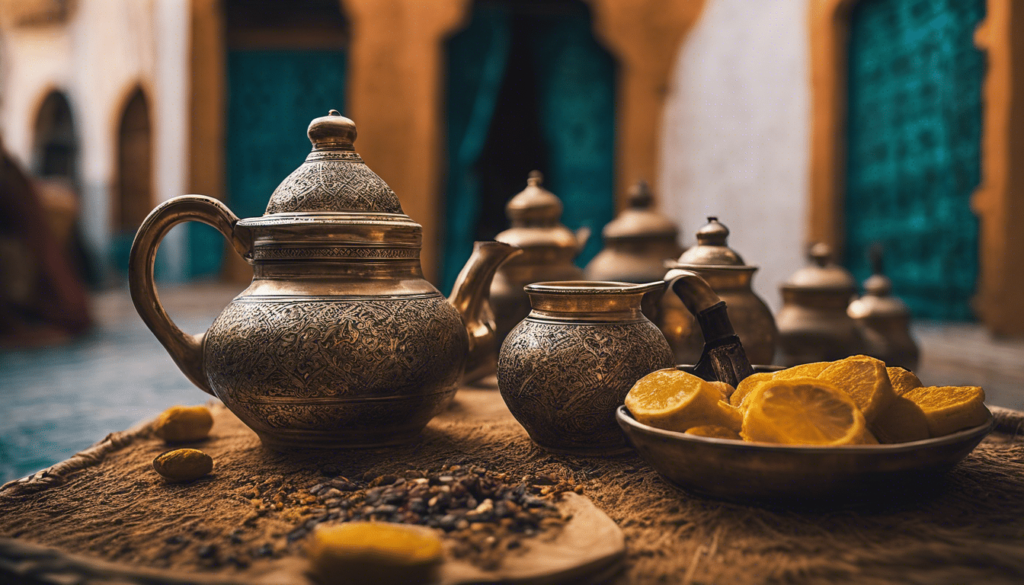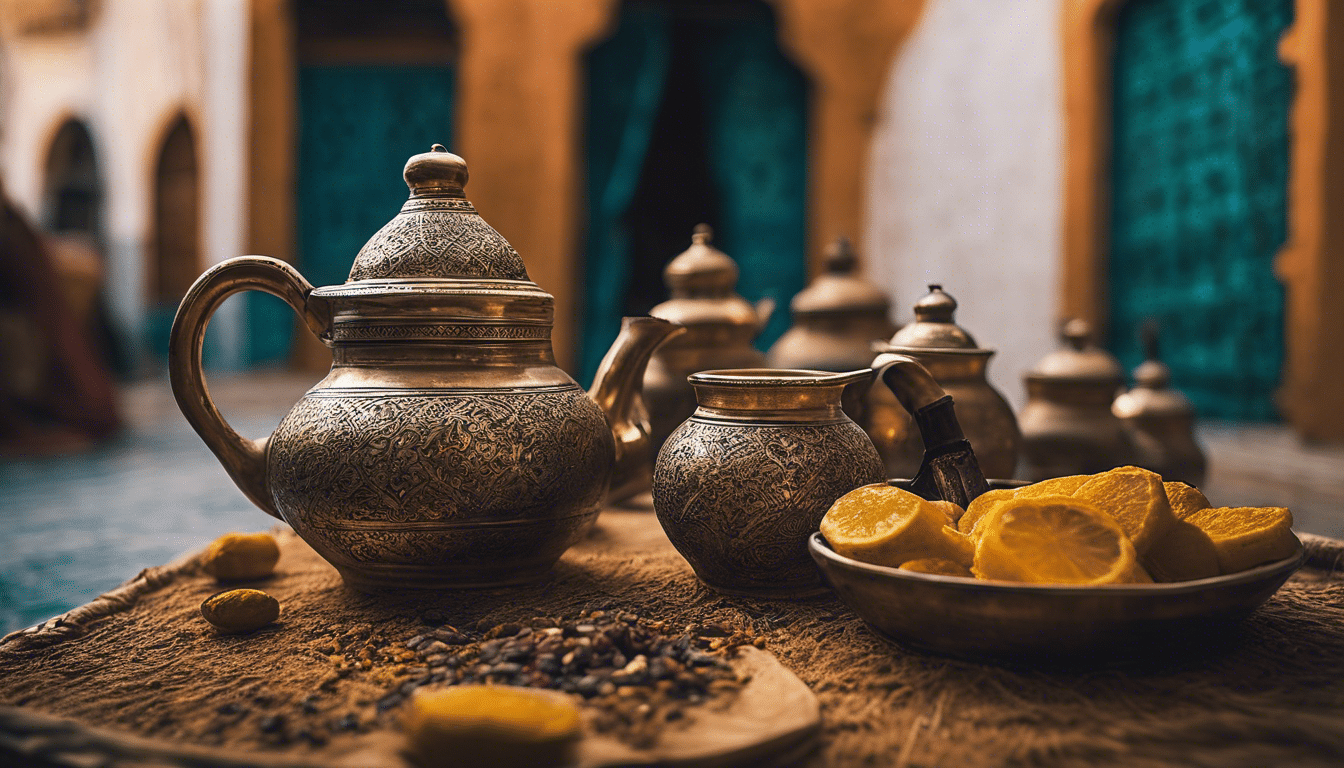
Moroccan hospitality is a tapestry woven with threads of warmth, generosity, and tradition, and at its heart lies the ritual of mint tea. Known as “atay bi nana” in Moroccan Arabic, this aromatic beverage transcends mere refreshment to embody a cultural institution. Served in intricately designed glasses, the tea blends green tea leaves, fresh mint, and sugar into a symphony of flavors that delights the senses. Its preparation and presentation are acts of connection, symbolizing welcome and respect for guests. In a land where hospitality is sacred, mint tea is more than a drink—it’s a gesture of unity, a bridge between host and visitor, and a cornerstone of social life. This article explores the profound role of mint tea in Moroccan customs, tracing its historical roots, social significance, and enduring presence in daily life.
The Historical Roots of Mint Tea in Morocco
Mint tea’s journey to Morocco began in the 18th century, introduced through trade with Europe. Green tea, originally from China, arrived via British merchants, but Moroccans transformed it by adding local mint and sugar. This adaptation reflects Morocco’s history as a crossroads of cultures, blending influences into something distinctly its own. By the 19th century, tea had become a staple, especially in the Maghreb region, where it gained ritualistic importance. Historical accounts, such as those from the Moroccan National Tourism Office, highlight how tea ceremonies evolved as symbols of diplomacy and trade. The beverage’s rise coincided with Morocco’s growing role in global commerce, making it a fitting emblem of the nation’s welcoming spirit.
The Art of Preparation: A Ritual of Care
Preparing mint tea is an art form that demands precision and patience. It begins with boiling water and rinsing green tea leaves—typically gunpowder tea—to remove bitterness. Fresh mint leaves, plucked from abundant Moroccan gardens, are then added, followed by generous amounts of sugar. The mixture steeps briefly before being poured from a height into small, ornate glasses, creating a frothy top that signifies expertise. This process, often performed by the male head of the household, is a public display of skill and hospitality. According to The Spruce Eats, the pouring technique aerates the tea, enhancing its flavor and signaling the host’s dedication to their guests’ enjoyment. Every step is deliberate, turning a simple drink into a meaningful ritual.
Mint Tea as a Symbol of Welcome
In Moroccan homes, offering mint tea is the first act of hospitality. Guests are greeted with the scent of mint wafting through the air, a sensory invitation to relax and connect. Refusing a cup is rare, as it might be seen as rejecting the host’s kindness. The tea is served in rounds—typically three—each slightly sweeter than the last, symbolizing the deepening of bonds. This tradition stems from Bedouin influences, where sharing sustenance in the desert was a matter of survival and trust. Today, it’s a universal gesture across urban and rural Morocco, from bustling medinas to remote villages, reinforcing the cultural value of generosity embedded in every sip.
Social Bonds Forged Over Tea
Mint tea is the lifeblood of Moroccan social gatherings. Whether it’s a family celebration, a business negotiation, or a casual visit, the tea tray is ever-present. Conversations flow as glasses are refilled, creating an atmosphere of camaraderie. The act of serving tea fosters equality—everyone, regardless of status, partakes in the same ritual. Scholars like those at Oxford Islamic Studies Online note that this practice reflects Morocco’s communal ethos, where relationships take precedence over haste. In a fast-moving world, the slow pace of tea drinking offers a counterpoint, encouraging presence and dialogue. It’s a space where stories are shared, deals are struck, and friendships are nurtured.
The Ceremonial Aesthetics: Glassware and Presentation
The visual appeal of mint tea is as vital as its taste. The tea is served in small, colorful glasses adorned with geometric patterns, often hand-painted, reflecting Morocco’s rich artisanal heritage. Silver teapots, polished to a gleam, elevate the experience, their curved spouts designed for the dramatic pour. The froth atop each glass is a mark of quality, while the vibrant green of the mint leaves peeking through the amber liquid adds natural beauty. This aesthetic, detailed by Smithsonian Magazine, underscores the Moroccan belief that hospitality should engage all senses, transforming a simple offering into a feast for the eyes as well as the palate.
Mint Tea in Everyday Life
Beyond formal gatherings, mint tea permeates daily routines. Street vendors in Marrakech’s souks pour it for weary shoppers, while families sip it during afternoon breaks. Its sweetness provides an energy boost, and the mint offers a cooling respite in Morocco’s warm climate. In rural areas, where fresh ingredients are abundant, it’s a household staple, often paired with bread or pastries. The tea’s versatility—served hot in winter and occasionally chilled in summer—ensures its year-round relevance. This ubiquity highlights its role as a cultural anchor, adapting to modern life while retaining its traditional essence, a balance Morocco navigates with grace.
Gender Roles and the Tea Ceremony
Traditionally, men prepare and serve mint tea, a custom tied to their historical role as public hosts. In domestic settings, this duty often falls to the eldest male, who takes pride in mastering the craft. However, women play an equally vital role, cultivating mint and managing the ingredients behind the scenes. In contemporary Morocco, these lines are blurring, with younger generations sharing responsibilities. Research from The Middle East Institute suggests this shift mirrors broader societal changes, yet the tea ceremony remains a male-led performance in formal contexts. This interplay of gender adds depth to the tradition, blending heritage with evolving norms.
Health Benefits and Cultural Perceptions
Mint tea isn’t just a social custom—it’s a wellness ritual. The combination of green tea’s antioxidants, mint’s digestive properties, and sugar’s quick energy aligns with Moroccan views on holistic health. Locals believe it aids digestion after rich meals like tagine, a claim supported by studies from Healthline. While the high sugar content raises modern health concerns, traditionalists argue it’s integral to the experience, a small indulgence in a balanced diet. This duality—pleasure and practicality—mirrors Morocco’s approach to life, where enjoyment and utility coexist. The tea’s perceived benefits reinforce its status as a cultural elixir, sipped for both body and soul.
Mint Tea in Moroccan Literature and Art
The beverage’s influence extends into Morocco’s creative expressions. Poets like Mohammed Bennis have likened its preparation to the crafting of verse—deliberate and layered. In visual art, scenes of tea ceremonies appear in paintings and photography, capturing the interplay of light on glass and steam. Moroccan cinema, too, uses tea as a motif for connection, as seen in films like Casablanca Beats. These depictions, explored by JSTOR, elevate mint tea from a daily habit to a symbol of national identity. Its presence in art underscores its role as a muse, inspiring reflections on hospitality, community, and the beauty of the ordinary.
Comparison Table: Mint Tea vs. Other Hospitality Drinks
| Drink | Origin | Key Ingredients | Cultural Role |
|---|---|---|---|
| Moroccan Mint Tea | Morocco | Green tea, mint, sugar | Symbol of welcome and connection |
| Turkish Coffee | Turkey | Coffee grounds, sugar | Fortune-telling and conversation |
| British Tea | United Kingdom | Black tea, milk | Afternoon ritual and formality |
This table highlights how mint tea stands apart, blending refreshment with profound social meaning unique to Morocco.
Mint Tea in Modern Morocco
As Morocco modernizes, mint tea adapts without losing its soul. Cafés in Casablanca serve it alongside espresso, catering to globalized tastes, while tourists flock to tea houses in Fez for an authentic experience. The rise of packaged tea blends has sparked debate about tradition versus convenience, yet fresh preparation remains the gold standard. Younger Moroccans experiment with less sugar or new herbs, reflecting health trends, but the core ritual endures. This resilience speaks to the tea’s adaptability, ensuring it remains a touchstone of hospitality amid change, a bridge between past and future.
The Global Influence of Moroccan Mint Tea
Morocco’s tea culture has rippled beyond its borders. In Spain’s Andalusia, with its Moorish heritage, mint tea echoes Moroccan influence. North African diaspora communities in France and the U.S. preserve the tradition, introducing it to new audiences. Travel blogs and cookbooks, like those on BBC Good Food, celebrate its simplicity, encouraging global home cooks to recreate it. This spread amplifies Morocco’s reputation as a beacon of hospitality, with mint tea as its ambassador. Its universal appeal lies in its accessibility—anyone, anywhere, can share in its warmth.
FAQs About Mint Tea in Moroccan Hospitality
What makes mint tea central to Moroccan hospitality?
It’s a universal gesture of welcome, symbolizing generosity and connection across all social settings.
How is the tea traditionally prepared?
Green tea is steeped with fresh mint and sugar, poured from a height to create froth, showcasing skill and care.
Can women perform the tea ceremony?
Traditionally male-led, the practice is evolving, with women increasingly participating in modern contexts.
Why is it served in three rounds?
Each round, growing sweeter, represents life’s stages—bitter, pleasant, and sweet—deepening guest-host bonds.
Is mint tea healthy?
It offers antioxidants and digestive benefits, though its sugar content is a point of modern debate.
Conclusion: The Enduring Legacy of Mint Tea
Mint tea is the heartbeat of Moroccan hospitality, a tradition that weaves together history, art, and human connection. From its origins as a trade import to its status as a national emblem, it reflects Morocco’s ability to embrace and transform influences into something extraordinary. The ritual of its preparation and sharing transcends generations, adapting to modernity while preserving its essence. It’s a testament to the power of small acts—pouring a glass, offering a seat—to forge lasting bonds. As Morocco continues to captivate the world, mint tea remains its most eloquent ambassador, inviting all to partake in a culture where hospitality is not just a custom, but a way of life.

